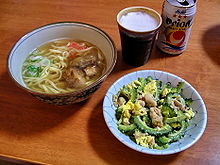- Okinawan cuisine
-

This article is part of the series Japanese cuisine
日本料理Regional cuisinesIngredientsBento • Main dishes • Desserts • Noodles • Sashimi • Sushi
Preparation and cookingUtensilsRituals & FestivalsEtiquette • Kaiseki • Japanese New Year
 Japan portal
Japan portalOkinawan cuisine is the cuisine of the Japanese island of Okinawa. Due to difference in culture, climate, vegetables and other ingredients between Okinawa and mainland Japan, Okinawan cuisine is very different from Japanese cuisine.
Contents
History
Okinawan cuisine incorporated influence from Chinese cuisine and Southeast Asian cuisine due to trade. The sweet potato, introduced in Okinawa in 1605, became a staple food in Okinawa from then until the beginning of the 20th century. An article about Okinawan food written by Kikkoman stated that Goya (bitter melon) and Nabera (luffa or towel gourd) were "likely" introduced to Okinawa from Southeast Asia. Since Ryukyu had served as a tributary state to China, Ryukyuan cooks traveled to Fujian Province to learn how to cook Chinese food; Chinese influence seeped into Okinawa in that manner. The same Kikkoman article states that the method of distillation of awamori likely originated from Siam (Thailand) and traveled to Okinawa during the 15th century. After the lord of the Kagoshima Domain invaded the Ryukyus Okinawan cooks traveled to Japan to study Japanese cuisine, causing that influence to seep into Okinawan cuisine.[1] Besides vegetables and fruits, the influences with southern and southeastern Asia is evident in Okinawan cuisine in its use of herbs and spices used in these areas much more than on mainland Japan, such as turmeric. As on mainland Japan, ginger is an important ingredient in Okinawan cuisine, and arguably even more so.[citation needed]
Since Okinawans traditionally practiced shamanistic religion and did not encounter Buddhist influence, pork and goat meat formed traditional parts of the Okinawan diet while people on the main Japanese islands did not eat much meat until the mid-19th century. Okinawan sayings include the phrase that Okinawan cuisine "begins with pig and ends with pig" and "every part of a pig can be eaten except its hooves and its oink."[1]
The cuisine has evolved in modern times, especially because of the American military presence on Okinawa since the end of World War II.[citation needed]
Ingredients
- Fish
- Fruit
- pineapples
- papayas
- mangoes
- passionfruit
- guavas
- citrus fruit
- Vegetables
- Gōya/Bitter melon
- Hechima/Luffa
- Shikuwasa
- sweet potato
- seaweed
- garlic
- onions
- tomatoes
- salad leaves
- Bean products
- Tofuyō
- Rice products
Common Okinawan dishes
Main dishes
Side dishes
- Umi-budō
- Hirayachi
Alcoholic beverages
Health benefits
Traditionally Okinawans ate a diet that was up to 90% carbohydrates according to The Okinawa Diet Plan. Their favorites were the purple Okinawan sweet potato, rice, and bitter melon. Okinawans are known for their longevity. Five times as many Okinawans live to be 100 than the rest of Japan, and the Japanese are the longest lived nationality in the world.[2][page needed]
The belief that an Okinawan diet offers health benefits, especially longevity, has become popular in western countries in recent years. Modern Okinawan cuisine differs significantly from the traditional one - Spam, for example, is a new addition to the range of ingredients.
References
- ^ a b Ishige, Naomichi. "Food Forum Okinawa." Kikkoman. Retrieved on November 30, 2009.
- ^ National Geographic magazine, June 1993
- BEARE, Sally, (2006) 50 Secrets of the World's Longest-Living People, Marlowe & Co, NY
[1] http://mdn.mainichi-msn.co.jp/waiwai/archive/news/2006/06/20060607p2g00m0dm024000c.html
Categories:
Wikimedia Foundation. 2010.

